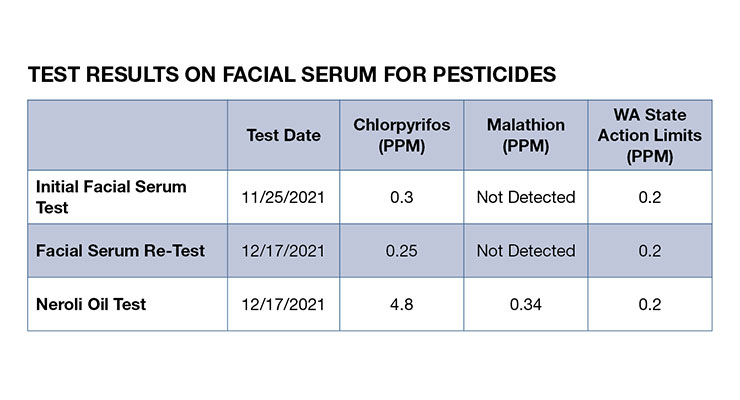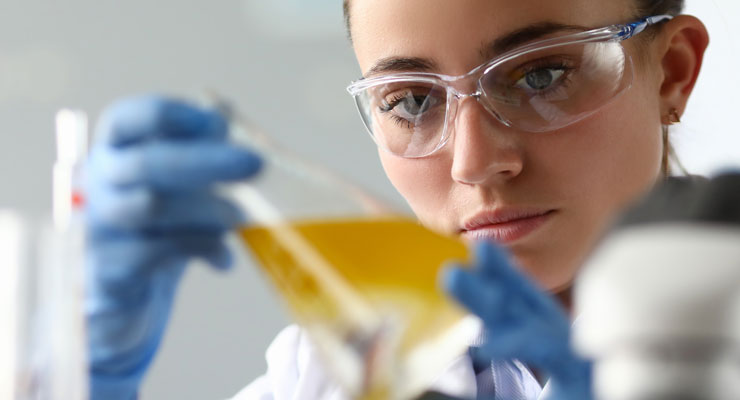By Eric Elgar, VP of Quality Operations, NeXtraction04.07.22
NeXtraction supplies raw CBDA/CBGA hemp extracts and pre-infused oil blends. Last year, we launched Kriva, a CBDA line of consumer products. We recently had an incident demonstrating the importance of good testing protocols and supply management. As per our normal procedure we tested a newly-developed facial serum for potency, heavy metals, pesticides, mycotoxins, and microbials. That’s what we do at Kriva—every time, for every product. Kriva is a line of lotions, gems, drops, soaps, and massage oil that contains CBDA.
After this particular test, we found a result that we are not used to seeing—detection of the pesticide Chlorpyrifos. It was more than a detection; it was a fail beyond action limits. This was an odd enough result to require a re-test, which we did with the same result.
The contaminant wasn’t the result of our procedures. We utilize NeXtraction’s H2Only, a water-based extraction method. We understand the testing to which NeXtraction submits its ingredients and hemp raw materials; it was not the
cannabinoid ingredient.
Having used the majority of the other botanical oils in previous products without issue, the suspicion quickly fell upon neroli oil, an expensive ingredient that was novel in our newest formulations. As such, we sent a sample of the neroli oil itself out for testing of residual pesticides and found that the oil exceeded the Washington State Action Limits for Chlorpyrifos by 24 times. Additionally, Malathion was detected beyond action limits, which must have been diluted below detection limits within the facial oil formulation.

In the end, the product didn’t get released to market and was destroyed. The supplier made good on at least the cost of the contaminated oil, while correctly pointing out that their customer is ultimately responsible for determining the purity and suitability of their product according to their terms and conditions. However, how many brands conduct a full panel test for each batch or lot on a topical cosmetic product, or alternatively, each lot of raw material ingredient received? As we move to utilize more natural ingredients in beauty products, we must be aware of these potential contaminants. How many things are we exposed to daily, unknowingly in the products that we use in our lives?
Extracting CBDA using NeXtraction’s H2Only extraction technology gives us an advantage as there is no pull through or concentration of residual pesticides or heavy metals, but we know far too well this is not the case for the vast majority of extraction methods utilized in the CBD market—nor for other botanical products that may be used as an ingredient. Further, there were no other residual solvents utilized in the H2Only process—again not the case for many botanical extracts. One needs to look no further than some of last year’s high profile recalls to understand the cost/benefits of testing and prevention.
It is only through diligent testing and robust quality oversight in the cosmetics industry that we can prevent harm to our customers and protect our organization from a costly recall event.
About the Author: Eric Elgar is VP of quality operations, NeXtraction. More info: (206) 351-7326; www.NeXtraction.com. To learn more about Kriva visit: www.kriva.co.
After this particular test, we found a result that we are not used to seeing—detection of the pesticide Chlorpyrifos. It was more than a detection; it was a fail beyond action limits. This was an odd enough result to require a re-test, which we did with the same result.
The contaminant wasn’t the result of our procedures. We utilize NeXtraction’s H2Only, a water-based extraction method. We understand the testing to which NeXtraction submits its ingredients and hemp raw materials; it was not the
cannabinoid ingredient.
Having used the majority of the other botanical oils in previous products without issue, the suspicion quickly fell upon neroli oil, an expensive ingredient that was novel in our newest formulations. As such, we sent a sample of the neroli oil itself out for testing of residual pesticides and found that the oil exceeded the Washington State Action Limits for Chlorpyrifos by 24 times. Additionally, Malathion was detected beyond action limits, which must have been diluted below detection limits within the facial oil formulation.

In the end, the product didn’t get released to market and was destroyed. The supplier made good on at least the cost of the contaminated oil, while correctly pointing out that their customer is ultimately responsible for determining the purity and suitability of their product according to their terms and conditions. However, how many brands conduct a full panel test for each batch or lot on a topical cosmetic product, or alternatively, each lot of raw material ingredient received? As we move to utilize more natural ingredients in beauty products, we must be aware of these potential contaminants. How many things are we exposed to daily, unknowingly in the products that we use in our lives?
Extracting CBDA using NeXtraction’s H2Only extraction technology gives us an advantage as there is no pull through or concentration of residual pesticides or heavy metals, but we know far too well this is not the case for the vast majority of extraction methods utilized in the CBD market—nor for other botanical products that may be used as an ingredient. Further, there were no other residual solvents utilized in the H2Only process—again not the case for many botanical extracts. One needs to look no further than some of last year’s high profile recalls to understand the cost/benefits of testing and prevention.
It is only through diligent testing and robust quality oversight in the cosmetics industry that we can prevent harm to our customers and protect our organization from a costly recall event.
About the Author: Eric Elgar is VP of quality operations, NeXtraction. More info: (206) 351-7326; www.NeXtraction.com. To learn more about Kriva visit: www.kriva.co.




























